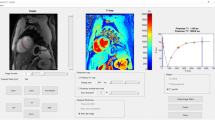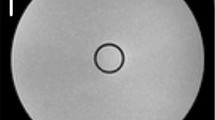Abstract
A new magnetic resonance imaging high-resolution sequence is presented that allows for the collection of all data for determination ofT 1 and ρ as well as for multiexponentialT 2 analysis within one measurement cycle.
Noise preprocessing is performed in order to avoid systematic errors in relaxation parameter analysis and to increase the interexperimental reproducibility of the results. ForT 2 analysis, an optimized Marquardt algorithm is used, in combination with image processing methods for both automatic detection of voxels with partial volume effects, and for speedup of the iterative nonlinear regression steps. Determination of longitudinal relaxation time is based on a sophisticated signal intensity ratio technique that computesT 1 as the mean of up to eight individualT 1 values, each weighted with its relativeT 2 decay. Relative proton density is computed using results of the evaluations of both relaxation times. Validation of the method is accomplished by comparing phantom measurements with reference data acquired with spectroscopic sequences.In vivo examples of the computed parameter images taken from a study of experimental cerebral infarcts in rats are presented.
The method allows one to acquire high-resolution parameter images within a measurement time that is tolerable even in clinical routine. Furthermore, the chosen evaluation concepts guarantee a short computation time. Therefore, an on-line computation of the parameter images and, in consequence, their direct use for diagnostic purposes appears feasible.
Similar content being viewed by others
References
Damadian R (1971) Tumor detection by nuclear magnetic resonance.Science 1711151–1153.
Bottomley PA, Foster TH, Argersinger RE, Pfeifer LM (1984) A review of normal tissue hydrogen NMR relaxation times and relaxation mechanisms from 1–100 MHz: dependence on tissue type, NMR frequency, temperature, species, excision and age.Med Phys 11425–448.
Beall PT, Amtey SR, Kasturi SR (1985)NMR Data Handbook for Biomedical Applications. New York: Pergamon Press.
Bottomley PA, Hardy CJ, Argersinger RE, Allen-Moore G (1987) A review of1H nuclear magnetic resonance relaxation in pathology: AreT 1 andT 2 diagnostic?Med Phys 141–37.
Gersonde K, Felsberg L, Tolxdorff T, Ratzel D, Ströbel B (1984) Analysis of multipleT 2 proton relaxation processes in human head and imaging on the basis of selective and assignedT 2 values.Magn Reson Med 1 463–477.
Just M, Higer HP, Schwarz M, Bohl J, Fries G, Pfannenstiel P, Thelen M (1988) Tissue characterization of benign brain tumors: Use of NMR tissue parameters.Magn Reson Imaging 6 463–472.
Schad LR, Brix G, Zuna I, Härle W, Lorenz WJ, Semmler W (1989) Multiexponential proton spin-spin relaxation in MR imaging of human brain tumors.J Comp Assist Tomogr 13 577–587.
Kjaer L, Thomsen C, Henriksen O (1989) Evaluation of biexponential relaxation behaviour in the human brain by magnetic resonance imaging.Acta Radiol 30 433–437.
Hoehn-Berlage M, Tolxdorff T, Bockhorst K, Okada Y, Ernestus R-I (1992) In vivo NMRT 2 relaxation of experimental brain tumors in the cat: A multiparameter tissue characterization.Magn Reson Imaging 10 935–947.
Pykett IL, Rosen BR, Buonanno FS, Brady TJ (1983) Measurement of spin-lattice relaxation times in nuclear magnetic resonance imaging.Phys Med Biol 28 723–729.
Lin MS (1984) Measurement of spin-lattice relaxation times in double spin-echo imaging.Magn Reson Med 1 361–369.
Kjos BO, Ehman RL, Brant-Zawadzki M (1985) Reproducibility ofT 1 andT 2 relaxation times calculated from routine MR imaging sequences: Phantom study.Am J Roentgenology 144 1157–1163.
Redpath TW (1982) Calibration of the Aberdeen NMR imager for proton spin-lattice relaxation time measurements in vivo.Phys Med Biol 271057–1065.
Bydder GM, Young IR (1985) MRI: Clinical use of the inversion recovery sequence.J Comp Assist Tomogr 9 1020–1032.
Edelstein WA, Bottomley PA, Hart HR, Smith LS (1983) Signal, noise, and contrast in nuclear magnetic resonance (NMR) imaging.J Comp Assist Tomogr 7 391–401.
Kurland RJ (1985) Strategies and tactics in NMR imaging relaxation time measurements. I. Minimizing relaxation time errors due to image noise—the ideal case.Magn Reson Med 2136–158.
Gowland PA, Leach MO, Sharp JC (1989) The use of an improved inversion pulse with the spin echo/inversion recovery sequence to give increased accuracy and reduced imaging time forT 1-measurements.Magn Reson Med 12 261–267.
Schneiders NJ, Ford JJ, Bryan RN (1985) AccurateT 1 and spin density NMR images.Med Phys 12 71–76.
Young IR, Hall AS, Bydder GM (1987) The design of a multiple inversion recovery sequence forT 1-measurement.Magn Reson Med 5 99–108.
Brix G, Schad LR, Deimling M, Lorenz WJ (1990) Fast and preciseT 1 imaging using a TOMROP sequence.Magn Reson Imaging 8 351–356.
Crawley AP, Henkelman RM (1988) A comparison of one-shot and recovery methods inT 1-imaging.Magn Reson Med 7 23–34.
Haase A (1990) Snapshot FLASH MRI. Applications toT 1,T 2, and chemical shift imaging.Magn Reson Med 13 77–89.
Haase A, Matthaei D, Bartkowski R, Dühmke E, Leibfritz D (1989) Inversion recovery snapshot FLASH MR imaging.J Comp Assist Tomogr 131036–1040.
Hoehn-Berlage M, Norris DG, Bockhorst K, Ernestus R-I Kloiber O, Bonnekoh P, Leibfritz D, Hossmann K-A (1992)T 1 snapshot FLASH measurement of rat brain glioma: Kinetics of the tumor-enhancing contrast agent Manganese (III) Tetraphenylporphine Sulfonate.Magn Reson Med 27201–213.
Look DC and Locker DR (1970) Time saving in measurements of NMR and EPR relaxation times.Rev Sci Instrum 41 250–251.
Gowland PE, Mansfield P (1993) Accurate measurement ofT 1 in vivo in less than 3 seconds using echoplanar imaging.Magn Reson Med 30 351–354.
Matthaei D, Haase A, Henrich D, Dühmke E (1992) Fast inversion recoveryT 1 contrast and chemical shift contrast in high resolution snapshot FLASH MR images.Magn Reson Imaging 10 1–6.
Conturo TE, Price RR, Beth AH, Mitchell MR, Partain CL, James AE (1986) Improved determination of spin density,T 1andT 2 from a three-parameter fit to multiple-delay-multiple- echo (MDME) NMR images.Phys Med Bid 31 1361–1380.
Riederer SJ, Bobman SA, Lee JN, Farzaneh F, Wang HZ (1986) Improved precision in calculatedT 1 MR images using multiple spin-echo acquisition.JComp Assist Tomogr 10 103–110.
Marquardt DW (1963) An algorithm for the estimation of non-linear parameters.Soc Ind Appl Math J 11431–441.
Handels H (1992)Automatische Analyse mehrdimensionaler Bilddaten zur Diagnoseunterstützung in der MR-Tomographie. Aachen, Germany: Shaker.
Jostes C (1990)Entzvicklung und Implementierung eines Verfahrens zur Parameterschätzung bei multiexponentiellen T 2-Relaxationsprozessen in der MR-Tomographie. Aachen, Germany: RWTH (Rheinisch Westfälische Technische Hochschule) Aachen (diploma thesis).
Conturo TE, Beth AH, Arenstorf RF, Price RR (1987) Simplified mathematical description of longitudinal recovery in multiple-echo sequences.Magn Reson Med 4 282–288.
Hahn EL (1950) Spin echoes.Phys Rev 80 580–594.
Carr HY, Purcell EM (1954) Effects of diffusion on free precession in NMR experiments.Phys Rev 94 630–638.
Meiboom S, Gill D (1958) Modified spin echo method for measuring nuclear relaxation times.Rev Sci Instrum 29 688–691.
Eis M (1993)Entwicklung von Verfahren zur quantitativen Magnet-Resonanz-Bildgebung der Relaxation und Diffusion und deren Anwendung in der experimentellen Neurologie. Aachen, Germany: Verlag Mainz.
Eis M, Hoehn-Berlage M, Bockhorst K, Hossmann K-A (1991) A time efficient method for combinedT 1/T 2 relaxation time measurements. Evaluation for multiparameter tissue characterization. InBook of Abstracts of the 10th Annual Meeting of the Society of Magnetic Resonance in Medicine (Society of Magnetic Resonance in Medicine eds) Berkeley, CA p. 701.
Kraft KA, Fatouros PP, Clarke GD, Kishore PRS (1987) A MRI phantom material for quantitative relaxometry.Magn Reson Med 5 555–562.
Santyr GE, Henkelman RM, Bronskill MJ (1988) Variation in measured transverse relaxation in tissue resulting from spin locking with the CPMG sequence.J Magn Reson 7928–44.
James F, Roos M (1967/85)MINUIT— Function minimization and error analysis. Geneva: CERN Computer Centre (program library, utility D506).
Edelstein W, Glover G, Hardy C, Redington R (1986) The intrinsic signal-to-noise ratio in NMR imaging.Magn Reson Med 3 604–618.
Bellon EM, Haacke EM, Coleman PE, Sacco DC, Steiger DA, Gangarosa RE (1986) MR-artifacts: a review.Am J Roentgenology 1471271–1281.
Edelstein W, Bottomley PA, Pfeifer LM (1984) A signal-to-noise calibration procedure for NMR imaging systems.Med Phys 11180–185.
Henkelman RM (1985) Measurement of signal intensities in the presence of noise in MR images.Med Phys 12 232–233.
Handels H, Tolxdorff T, Bohndorf K (1990) Preprocessing of magnetization decays to improve multiexponentialT 2 analysis. InTissue Characterization in MR Imaging (Higer H-P and Bielke G, eds) pp. 69–74. Berlin: Springer-Verlag
Barroilhet LE, Moran PR (1975) Nuclear magnetic resonance (NMR) relaxation spectroscopy in tissues.Med Phys 2191–194.
Chang DC, Hazlewood CF, Woessner DE (1976) The spin-lattice relaxation times of water associated with early post mortem changes in skeletal muscle.Biochim Biophys Ada 437 253–258.
Sandhu HS, Friedmann GB (1978) Proton spin-lattice relaxation time study in tissues of the adult newt Taricha granulosa (Amphibia: Urodele).Med Phys 5 514–517.
Bakker CJG, Vriend J (1984) Multiexponential water proton spin-lattice relaxation in biological tissues and its implications for quantitative NMR imaging.Phys Med Bid 29 509–518.
Barthwal R, Hoehn-Berlage M, Gersonde K (1986) In vitro protonT 1 andT 2 studies on rat liver: Analysis of multiexponential relaxation processes.Magn Reson Med 3 836–875.
Kamman RL, Bakker CJG, van Dijk P, Stomp GP, Heiner AP, Berendsen HJC (1987) Multiexponential relaxation analysis with MRI and NMR spectroscopy using fat-water systems.Magn Reson Imag 5 381–392.
Armspach JP, Gounot D, Rumbach L, Chambron J (1991) In vivo determination of multiexponentialT 2 relaxation in the brain of patients with multiple sclerosis.Magn Reson Imaging 9 107–113.
Reul J, Handels H, Thron A, Lakenberg C, Herpers R (1992) Relaxometrische Differenzierung normaler und pathologischer Hirngewebe in der MR-Tomographie unter Verwendung einer histogrammbasierten Cluster-Analyse.Klin Neuromdiol 2 55–63.
Wirth N (1979)Algorithmen und Datenstrukturen. Stuttgart: Teubner.
Majumdar S, Orphanoudakis SC, Gmitro A, O'Donnell M, Gore JC (1986) Errors in the measurement ofT 2 using multiple-echo MRI-techniques. I: Effects of RF pulse imperfections.Magn Reson Med 3 397–417.
Crawley AP, Henkelman RM (1986) Suppression of stimulated echoes in multisliceT 2 imaging. InBook of Abstracts of the 5th Annual Meeting of the Society of Magnetic Resonance in Medicine (Society of Magnetic Resonance in Medicine eds) Berkeley, CA pp. 1061–1062.
Wilmes LJ, Hoehn-Berlage M, Els T, Bockhorst K, Eis M, Bonnekoh P, Hossmann K-A (1993) In vivo relaxometry of three brain tumors in the rat: Effect of Mn-TPPS, a tumor-selective contrast agent.Journal of Magnetic Resonance Imaging 35–12.
Constable RT, Henkelman RM (1991) Data extrapolation for truncation artifact removal.Magn Reson Med 17 108–118.
Handels H, Tolxdorff T (1990) A new segmentation algorithm for knowledge acquisition in tissue characterizing NMR imaging.J Digit Imaging 3 89–94.
Handels H, Hiestermann A, Tolxdorff T, Thron A, Bohndorf K, Eis M (1990) Automatic segmentation of tissue in 3D voxel space based on multidimensional MR parameter histograms. InBook of Abstracts of the 9th Annual Meeting of the Society of Magnetic Resonance in Medicine (Society of Magnetic Resonance in Medicine eds) Berkeley, CA p. 556.
Handels H (1993) Automatic segmentation and classification of multiparametric image data in medicine. InStudies in Classification, Data Analysis and Knowledge Organization. (Klar R, Lausen B, Opitz O, eds). pp. 452–460 Berlin: Springer-Verlag.
Eis M, Handels H, Hoehn-Berlage M, Wilmes LJ, Ernestus R-I, Kloiber O, Tolxdorff T, Hossmann K-A (1991) Fully automatic tissue characterization in rat brain at 4.7 T. InBook of Abstracts of the 10th Annual Meeting of the Society of Magnetic Resonance in Medicine (Society of Magnetic Resonance in Medicine eds) Berkeley, CA p. 1214.
Author information
Authors and Affiliations
Rights and permissions
About this article
Cite this article
Eis, M., Hoehn-berlage, M. A time-efficient method for combinedt 1 andt 2 measurement in magnetic resonance imaging: Evaluation for multiparameter tissue characterization. MAGMA 2, 79–89 (1994). https://doi.org/10.1007/BF01753063
Received:
Revised:
Issue Date:
DOI: https://doi.org/10.1007/BF01753063




